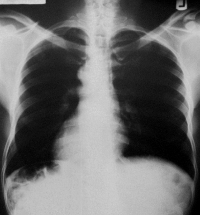Situs Inversus in A 53 Year Old Man: A Case Report
DOI:
https://doi.org/10.60787/tnhj.v11i1.48Keywords:
Dextrocardia, Situs Inversus, Totalis, Nigerian male.Abstract
Background: Total or complete visceral situs inversus is the complete inversion of position of the thoracic and abdominal viscera. It may be isolated or associated with malformations, especially cardiac or alimentary. It may be discovered in infancy because of associated anomalies but often remains asymptomatic and discovered by chance in adult life.
Method: The case records of the index patient and literature review on the subject were utilized.
Result: A 53 year old man was referred to the cardiology clinic from the general outpatient department on account of an abnormal ECG. On examination his apex could not be located on the left and was subsequently located on the right 5th intercostal space mid-clavicular line. Examination of the abdomen revealed an inversion of position of the liver and spleen.
Chest X-ray showed the heart in the right hemithorax with the cardiac apex pointing to the right, the aortic arch and gastric air bubble were located on the right as well.
Lungs and thoracic cage were normal. Echocardiography showed a mirror image dextrocardia. While electrocardiography revealed inverted P waves in lead 1 with predominantly downward QRS complexes in leads 1, V5 and V6. Abdominal scan showed mirror-image anatomy of the abdominal viscera.
Conclusion: Situs inversus totalis though a rare condition, should be sought for when clinical and radiologic findings indicate dextrocardia, especially as it may be an incidental finding.
Downloads
References
Fraser RS, Muller NL, Colman NC, Pare PD. Fraser thand Pare's Diagnosis of Diseases of the Chest. Vol 3. 4ed. Philadelphia, Pa: WB Saunders Co; 1999:2281-2283.
Gutgesell HP. Cardiac malposition and heterotaxy. In: Garson AG Jr, Fisher DJ, Neish SR, eds. Science and ndPractice of Pediatric Cardiology. Vol2. 2ed. Baltimore: Williams & Wilkins; 1998:1539-1561.
Splitt MP, Burn J, Goodship J. Defects in determination of left-right asymmetry. J Med Genet 1996; 33:498503.
Wilhelm A, Holbert JM. Situs Inversus, last updated Feb 24, 2009. eMedicine from WebMD.htm
Van Praag R. Terminology of congenital heart diseases, Glossary and commentary. Circulation 1977; 56: 139-143.
Bohun CM, Potts JE, Casey BM, Sandor GG. A population-based study of cardiac malformations and outcomes associated with dextrocardia. Am J Cardiol 2007; 100(2):305-309.
Ortega HA, Vega Nde A, Santos BQ, Maia GT. Primary ciliary dyskinesia: considerations regarding six cases ofKartagener syndrome. J Bras Pneumol 2007; 33(5):602-608.
Holzmann D, Ott PM, Felix H. Diagnostic approach to primary ciliary dyskinesia: a review. Eur J Pediatr 2000; 159(1-2):95-98.
Kennedy MP, Omran H, Leigh MW, et al. Congenital heart disease and other heterotaxic defects in a large cohort of patients with primary ciliary dyskinesia. Circulation 2007; 115(22):2814-2821.
Bamford RN, Roessler E, Burdine RD. Loss of function mutations in the EGF-CFC gene CFC1 are associated with human left-right laterality defects. Nat Genet 2000; 26:365369
Merklin RJ, Varano NR. Situs inversus and cardiac defects. A study of 111 cases of reversed asymmetry. J Thoracic and Cardiovasc Surg 1963; 45: 334-342.
Ugwu RO, Eneh AU, Otaigbe BE. Kartegener syndrome: an unusual cause of respiratory distress in the new born. Nig J Med 2006; 15:444-447.
Danbauchi SS, Alhassan MA. Case report: dextrocardia with situs inversus two cases presenting differently. Niger Postgrad Med J 2002; 9:248-252.
Adeyekun AA, Onunu AN, Mazeli FO. Dextrocardia with situs inversus: a case report. WestAfr J Med 2003; 22: 358-360

Downloads
Published
Issue
Section
License
Copyright (c) 2015 The Nigerian Health Journal

This work is licensed under a Creative Commons Attribution-NonCommercial-NoDerivatives 4.0 International License.
The Journal is owned, published and copyrighted by the Nigerian Medical Association, River state Branch. The copyright of papers published are vested in the journal and the publisher. In line with our open access policy and the Creative Commons Attribution License policy authors are allowed to share their work with an acknowledgement of the work's authorship and initial publication in this journal.
This is an open access journal which means that all content is freely available without charge to the user or his/her institution. Users are allowed to read, download, copy, distribute, print, search, or link to the full texts of the articles in this journal without asking prior permission from the publisher or the author.
The use of general descriptive names, trade names, trademarks, and so forth in this publication, even if not specifically identified, does not imply that these names are not protected by the relevant laws and regulations. While the advice and information in this journal are believed to be true and accurate on the date of its going to press, neither the authors, the editors, nor the publisher can accept any legal responsibility for any errors or omissions that may be made. The publisher makes no warranty, express or implied, with respect to the material contained herein.
TNHJ also supports open access archiving of articles published in the journal after three months of publication. Authors are permitted and encouraged to post their work online (e.g, in institutional repositories or on their website) within the stated period, as it can lead to productive exchanges, as well as earlier and greater citation of published work (See The Effect of Open Access). All requests for permission for open access archiving outside this period should be sent to the editor via email to editor@tnhjph.com.





